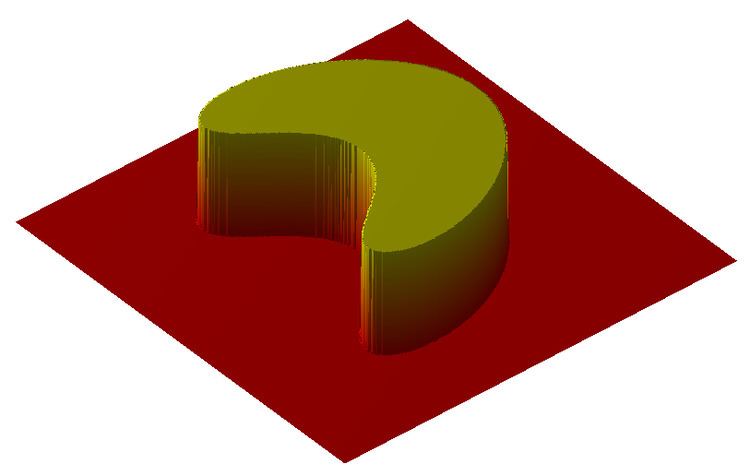 | ||
In mathematics, an indicator function or a characteristic function is a function defined on a set X that indicates membership of an element in a subset A of X, having the value 1 for all elements of A and the value 0 for all elements of X not in A. It is usually denoted by a symbol 1 or I, sometimes in boldface or blackboard boldface, with a subscript describing the set.
Contents
Definition
The indicator function of a subset A of a set X is a function
defined as
The Iverson bracket allows the equivalent notation,
The function
The set of all indicator functions on
Remark on notation and terminology
A related concept in statistics is that of a dummy variable. (This must not be confused with "dummy variables" as that term is usually used in mathematics, also called a bound variable.)
The term "characteristic function" has an unrelated meaning in probability theory. For this reason, probabilists use the term indicator function for the function defined here almost exclusively, while mathematicians in other fields are more likely to use the term characteristic function to describe the function that indicates membership in a set.
Basic properties
The indicator or characteristic function of a subset A of some set X, maps elements of X to the range {0,1}.
This mapping is surjective only when A is a non-empty proper subset of X. If A ≡ X, then 1A = 1. By a similar argument, if A ≡ Ø then 1A = 0.
In the following, the dot represents multiplication, 1·1 = 1, 1·0 = 0 etc. "+" and "−" represent addition and subtraction. "
If
and the indicator function of the complement of
More generally, suppose
is clearly a product of 0s and 1s. This product has the value 1 at precisely those x ∈ X that belong to none of the sets Ak and is 0 otherwise. That is
Expanding the product on the left hand side,
where |F| is the cardinality of F. This is one form of the principle of inclusion-exclusion.
As suggested by the previous example, the indicator function is a useful notational device in combinatorics. The notation is used in other places as well, for instance in probability theory: if
This identity is used in a simple proof of Markov's inequality.
In many cases, such as order theory, the inverse of the indicator function may be defined. This is commonly called the generalized Möbius function, as a generalization of the inverse of the indicator function in elementary number theory, the Möbius function. (See paragraph below about the use of the inverse in classical recursion theory.)
Mean, variance and covariance
Given a probability space
Characteristic function in recursion theory, Gödel's and Kleene's representing function
Kurt Gödel described the representing function in his 1934 paper "On Undecidable Propositions of Formal Mathematical Systems". (The paper appears on pp. 41–74 in Martin Davis ed. The Undecidable):
"There shall correspond to each class or relation R a representing function φ(x1, . . ., xn) = 0 if R(x1, . . ., xn) and φ(x1, . . ., xn) = 1 if ~R(x1, . . ., xn)." (p. 42; the "~" indicates logical inversion i.e. "NOT")Stephen Kleene (1952) (p. 227) offers up the same definition in the context of the primitive recursive functions as a function φ of a predicate P takes on values 0 if the predicate is true and 1 if the predicate is false.
For example, because the product of characteristic functions φ1*φ2* . . . *φn = 0 whenever any one of the functions equals 0, it plays the role of logical OR: IF φ1 = 0 OR φ2 = 0 OR . . . OR φn = 0 THEN their product is 0. What appears to the modern reader as the representing function's logical inversion, i.e. the representing function is 0 when the function R is "true" or satisfied", plays a useful role in Kleene's definition of the logical functions OR, AND, and IMPLY (p. 228), the bounded- (p. 228) and unbounded- (p. 279ff) mu operators (Kleene (1952)) and the CASE function (p. 229).
Characteristic function in fuzzy set theory
In classical mathematics, characteristic functions of sets only take values 1 (members) or 0 (non-members). In fuzzy set theory, characteristic functions are generalized to take value in the real unit interval [0, 1], or more generally, in some algebra or structure (usually required to be at least a poset or lattice). Such generalized characteristic functions are more usually called membership functions, and the corresponding "sets" are called fuzzy sets. Fuzzy sets model the gradual change in the membership degree seen in many real-world predicates like "tall", "warm", etc.
Derivatives of the indicator function
A particular indicator function is the Heaviside step function. The Heaviside step function is the indicator function of the one-dimensional positive half-line, i.e. the domain [0, ∞). It is well known that the distributional derivative of the Heaviside step function, indicated by H(x), is equal to the Dirac delta function, i.e.
with the following property:
The derivative of the Heaviside step function can be seen as the 'inward normal derivative' at the 'boundary' of the domain given by the positive half-line. In higher dimensions, the derivative naturally generalises to the inward normal derivative, while the Heaviside step function naturally generalises to the indicator function of some domain D. The surface of D will be denoted by S. Proceeding, it can be derived that the inward normal derivative of the indicator gives rise to a 'surface delta function', which can be indicated by δS(x):
where n is the outward normal of the surface S. This 'surface delta function' has the following property:
By setting the function f equal to one, it follows that the inward normal derivative of the indicator integrates to the numerical value of the surface area S.
